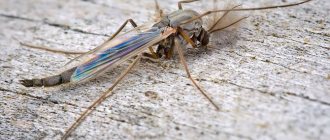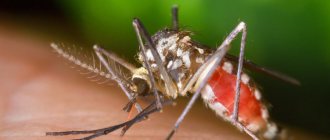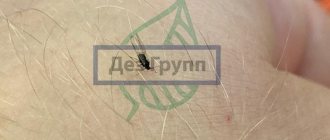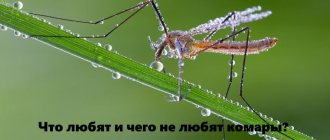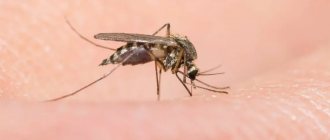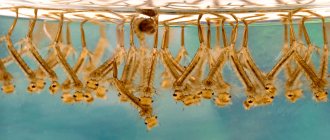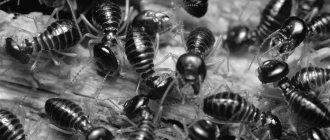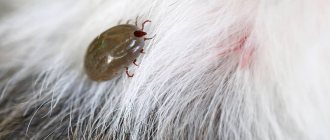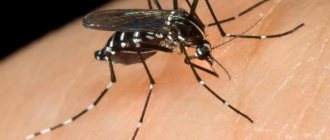Do you know what green mosquitoes are? These small insects are also called chironomids. They belong to the order Diptera. An adult can flap its wings up to 1000 times in 1 second. An adult individual, due to the fact that the oral apparatus is underdeveloped, cannot take food. But the larvae of bells feed on detritus, as well as microorganisms. Their habitat is natural silt. Interestingly, the larva can successfully exist at a depth of 300 meters. Some of them may be predators. Bell mosquitoes do not pose a danger to humans; their offspring serve as food for fish. Their habitats are very extensive; they can be seen near Russian reservoirs in reed thickets or in the northern part of Tunisia, for example.
Life cycle and other features
The ringing mosquito bothers you with its squeaks - this is its key harmfulness
Chironomids are divided into 3000 species. The life cycle of this insect is very short, only 7 days, in some species it is 3 days. Outwardly, they are not very noticeable, colored dark brown or yellowish-green. Why were they called bells? It turns out that males gather in huge flocks and soar in the air, emitting a specific ringing sound to attract a female. The female, having heard their call, following her instincts, flies into a huge flock of males. In just a couple of seconds, she flies out fertilized.
The second name is jerk mosquitoes, they received due to the peculiarity of landing on the surface. These insects rely only on the back and middle pair of legs. The forelimbs are always raised, so the body of the insect is continuously supported. This position of the body is due to the fact that they detect the approach of danger.
Up to 9 mm long, hairy green bells are larger than the common mosquito. Chironomids lay their eggs in mud, and the future offspring are covered in a common gelatinous transparent shell. The type of insect can be determined by the shape and location of the eggs. After some time, transparent larvae 25-30 mm long will emerge from the eggs. Repeatedly moulting, they acquire a scarlet color. This is due to the presence of hemoglobin in the hemolymph. Thanks to this, the red larvae of the mosquito mosquito can live in places where there is no oxygen. People call them bloodworms.
Mature larvae form pupa with tracheal gills on the muddy bottom of ponds or other bodies of water. As a result of metamorphosis, small green mosquitoes are formed inside the motionless pupae. Insects are released from the pupa using air. The capsule seems to be torn apart by the overflowing air.
Nutrition
Adults feed on fresh fly droppings, nectar, pollen, honeydew and various sugar-rich materials. Some species do not feed at all, since their oral organs are underdeveloped. The larvae feed on detritus and microorganisms, some are predators.
The larvae of some Psectrocladius species feed on filamentous algae (Spirogyra), the larvae of Cricotopus brevipalpis live in the leaves of pondweed, and the larvae of Cricotopus trifasciatus live on the surface of various aquatic plants. Tanypus species live as predators and prey on other insect larvae. Two Nanocladius species parasitize the stone fly Pteronarcys biloba. Chironomid larvae can also live on or in snails, mollusks, corals or sponges (Xenochironomus and Oukuriella).
Features of squeaks and bells
First of all, I would like to note that even though they are a Diptera order, they have enough differences. Squeaker mosquitoes are much smaller in body structure than their relatives, the jerks. The mouthparts of squeaks are piercing-sucking, while in bells it is underdeveloped. The female squeak mosquito must drink blood in order to continue her race, while the male feeds only on plant juices. Squeaking mosquitoes don’t even think about food; their digestive system is undeveloped. For the same reason, the insect does not bite. The lifespan of these 2 species is very different.
Important! Bloodsucking mosquitoes live 42-115 days; their life expectancy is affected by temperature, habitat, and gender. For example, females live longer than males. Bell mosquitoes have a much shorter lifespan, it is 1 week, in some species it is only 3 days.
Taxonomy
The systematics of chironomids is currently an intensively developing field of entomology. Recently, it has received a new impetus in development after the introduction of karyosystematics methods and the discovery of twin species that differ well in karyotypes and poorly in morphology. If earlier the taxonomy of chironomids was complicated by the fragmentation of identification systems for the preimaginal stages of development, studied by hydrobiologists, and the imaginal stages, studied by entomologists, now the problem is the comparison of data from taxonomists-morphologists and taxonomists-cytologists.
The first guide to the morphology and taxonomy of chironomid larvae and pupae in Russia was the work of N. N. Lipina “Chironomid larvae and pupae,” which included information about 80 forms of these insects. But by the 1940s, the number of studied species and forms had almost tripled, requiring the creation of a new key to chironomids. The next milestone in the study of larvae was A. A. Chernovsky’s key. He well understood the great importance of this group of dipterans, since as a hydrobiologist he was faced with the problem of taxonomic determination of the larvae of a particular species. He was the first among domestic taxonomists to set himself the task of compiling such a key so that it could be used not only by hydrobiologists, but also by entomologists, ecologists, and representatives of other specialties
In his monograph, in addition to the identification tables, A. A. Chernovsky paid much attention to the biology of larvae, methods of collecting material, removing subsequent stages of development from larvae and preparing permanent preparations. He urged researchers to breed adults from larvae and pupae to obtain a complete picture of all stages of development of a particular species and the possibility of describing its morphological characteristics during the process of metamorphosis
This would make species identification much easier and more accurate.
A. A. Chernovsky used the Goetghebuer system as the basis for the taxonomic structure, making some original changes to it, dividing the Palearctic representatives of Chironomidae into 7 subfamilies: Tendipedinae (Chironominae), Orthocladiinae, Corynoneurinae, Clunioninae, Podonominae, Pelopiinae and Diamesinae. Chernovsky’s identification tables are characterized by clear formulations and brilliantly illustrated; they are still used by biologists of various profiles, and the family system he proposed changes slightly and, basically, is only supplemented (Petrova et al., 2004).
According to E. A. Makarchenko, in 2005, at least 5,000 species from 440 genera and 11 subfamilies were known for the world chironomid fauna: Tanypodinae, Aphroteniinae, Podonominae, Usambaromyiinae, Buchonomyiinae, Chilenomyiinae, Diamesinae, Prodiamesinae, Orthocladiinae, Chironominae and Telmatoge toninae. Chironomids of the subfamilies Aphroteniinae, Usambaromyiinae and Chilenomyiinae are distributed only in the Southern Hemisphere, all others are represented in the zoogeographic regions of the Northern Hemisphere. More than 1,500 species from 217 genera of 8 subfamilies have been registered for the Palaearctic, and 1,051 species from 205 genera for the Nearctic. All this information primarily relates to adults. Preimaginal stages of development are known at best for a third of taxa. According to data published in 2008 by Leonard Ferrington Jr. The chironomid fauna contains a total of 339 genera and 4147 species.
In the environment, habitats of chironomids are noted that have a high concentration of undescribed species:
- intermittent and ephemeral aquatic habitats;
- rivers and lakes of the most extreme low latitudes of the major northern or southern mountain ranges (for example, the southern Rockies in Arizona);
- high-lying streams and rivers;
- oceanic archipelagos.
Danger to humans
Such a swarm should not be allowed into the house - there are many means of protection
Bloodsucking squeaks can be carriers of diseases dangerous to humans and animals. For example, meningitis, infectious eczema, encephalitis. Therefore, if you are going outdoors, especially with small children, then you should think about how to protect yourself from bites. Children, as a rule, scratch bites until they bleed; this is very dangerous, because you can get streptoderma. Green mosquitoes are absolutely safe for humans, they can only annoy you with their ringing and are not carriers. Moreover, their larvae in the natural cycle are an indispensable food for vertebrate waterfowl.
| Insect | Body length | Lifespan | Nutrition | Wednesday | Life cycle | Carrier |
| Squeaker mosquito | from 2 to 8 mm | from 42 to 115 days | female by blood, male by plant juices | everywhere | egg, larva, pupa | miningitis, encephalitis |
| midge mosquito | from 7.5 to 11 | from to 7 days | doesn't eat | everywhere near bodies of water | egg, larva, pupa | can't stand it |
Development
Bell bell larvae live in silt near ponds and large puddles. Once born, they remain in the mucous membrane of the pouch for 20 hours. After this, development continues in the mud.
Initially, the worm-like larvae are colorless, body length no more than 1 mm. Gradually acquire a dark color. In an oxygen-deficient environment, bloodworms turn red. For movement, a soft, liquid soil substance is required. Baby green bells live near the shores of reservoirs with fresh and salt water. They have the ability to go deep up to 400 cm from the soil surface.
Mechanical protection
This annoying chironomid, with its ringing, causes discomfort in the house. Intrusive “musical accompaniment” prevents you from enjoying the silence of the night. Therefore, to prevent green mosquitoes in your apartment from disturbing your sleep, you should buy mosquito nets for your windows. A wide range is presented in specialized stores. Perhaps, for some reason, you cannot purchase them, then just attach a piece of gauze to the window using improvised means. This option is only suitable for wooden frames.
If you have a plastic window installed, you will have to allocate funds for a mosquito net. It is enough to know the dimensions of the window frame. Another protection option is a mosquito net with magnets, which serves as a reliable barrier to insects. It consists of 2 metal fasteners, a magnetic strip and a mesh. Mounted in the doorway leading to the street. The convenience is that wherever you go out, it will close right behind you.
Important! Spray some clove oil or anise oil on the mesh and keep the big green mosquitoes away from your home. As is known, the olfactory organs are located on the antennae of these insects, with the help of which they navigate in space. Also, it is on the antennas that there are receptors that sense temperature fluctuations.
Where are ringing mosquitoes found?
They are the indigenous inhabitants of most of the planet. According to research, the distant ancestors of these insects appeared more than 250 million years ago and since then, relative to other species, individuals have changed little. The amazing survival rate is due to several factors:
- Firstly, bells are highly adaptable. They feel equally good both in the steppes of Kazakhstan and in the taiga regions of Russia, forests in the middle zone, and temperate climates.
- Secondly, these insects are very prolific. The larvae, in turn, easily survive the competition of other creatures, not disdaining both plant roots and deposits of rotting matter.
All this has led to the fact that ringing mosquitoes are found everywhere. In Russia alone there are about a thousand species. They are also found in Africa, in wild untouched forests. Scientists suggest that the adaptability of species is so great that we can expect further exploration of the planet.
Related articles: How many species of mosquitoes live in Russia and which of them are dangerous
Go to website
Chemical remedies
First of all, before applying chemicals, you need to make sure that they are safe for health. It is interesting that mosquitoes have poor vision and hearing, but a well-developed sense of smell - at a distance of 1.3 meters the insect can distinguish a living object. The remedy can be collective:
- electric fumigator;
- Mosquito nets;
- smoke bombs;
- sticky tapes;
- mosquito coils.
No less effective are personal protective equipment - sprays, creams, aerosols. They have a repellent effect. Such repellents interrupt human pheromones, making them invisible to the “eyes” of insects.
More documents from the pedagogy category:
Class hour “What is good and what is bad?”
Scenario of the solemn event dedicated to the Day of the withdrawal of Soviet troops from Afghanistan
Training “Look at the world positively”
Open lesson “Journey to Morpheme Island”
Tolerance lesson “How to become a tolerant person” 8th grade
Pedagogical project “Spiritual and moral education based on materials from the history of art of the Perm region”
Celebration of knowledge “Clever Men and Women”
Code for use on the site:
To download a document, please recommend it to your friends on any social network. networks.
Then the “DOWNLOAD”
will become available!
The buttons are located just below. Thank you!
Buttons:
Know by your mustache what to call Vanka
Fast forward to 1878. There is a man standing on a hillock near the river, with reporters gathered around him. The man lifts up a forked steel fork and hits it - once, twice, three times. There is a shaking sound. This is a tuning fork. The man continues to make monotonous sounds. And... Oh, miracle! Bell-bellied mosquitoes begin to gather above his head, and every moment there are more and more of them. And now this is a small black cloud. Reporters are delighted! Bravo, Lord of the Flies!
The man with the tuning fork was Hiram Stevens Maxim. The same one that, 5 years later, will create the most famous machine gun. A deadly machine. It’s a pity that Hiram Maxim will be remembered in human memory only as the inventor of the machine gun
But he contributed to the development of entomology by making an important biological discovery.
When the inventor was installing electric lights in New York, he noticed that a humming transformer attracted mosquitoes. They curl and dance around him. Hiram picked up a tuning fork, similar in sound to a transformer, and began to attract mosquitoes with the sound
Maxim also found out that the tuning fork attracts mosquitoes with antennae, but insects without antennae do not react to it.
The inventor put forward an amazing hypothesis - the ears of mosquitoes are on the whiskers! He wrote about it in the newspaper. Contemporaries laughed at him at first, but then scientists not only confirmed this guess, but also found olfactory cilia on the antennae. These are the antennae mosquitoes have! They are ears, they are nose!
Also, bell mosquitoes exhibit sexual dimorphism in their antennae. Sexual dimorphism is the external differences between a female and a male. For example, striking dimorphism in chicken and rooster. And among twitchers, males have hussar mustaches, while in females they are much more modest, not so fluffy. Without antennae, the genus of ringing mosquitoes would be interrupted.
But let's return to our extraordinary phenomenon. To be fair, it is worth noting that such swarms are formed not only by bells, but also by other mosquitoes, for example, coretras. And there were some oddities in history. One day the fire brigade arrived at a plume of smoke above the church. The alarm turned out to be false: it was mosquitoes.
I wish you interesting observations of spring! And I invite you to join our spring marathon “SPRING IS COMING”. This is an immersion into the wonderful world of research, creativity and play! You still have time to participate in the first stage of the adventure.
Hiram picked up a tuning fork, similar in sound to a transformer, and began to attract mosquitoes with the sound. Maxim also found out that the tuning fork attracts mosquitoes with antennae, but insects without antennae do not react to it.
The inventor put forward an amazing hypothesis - the ears of mosquitoes are on the whiskers! He wrote about it in the newspaper. Contemporaries laughed at him at first, but then scientists not only confirmed this guess, but also found olfactory cilia on the antennae. These are the antennae mosquitoes have! They are ears, they are nose!
Also, bell mosquitoes exhibit sexual dimorphism in their antennae. Sexual dimorphism is the external differences between a female and a male. For example, striking dimorphism in chicken and rooster. And among twitchers, males have hussar mustaches, while in females they are much more modest, not so fluffy. Without antennae, the genus of ringing mosquitoes would be interrupted.
But let's return to our extraordinary phenomenon. To be fair, it is worth noting that such swarms are formed not only by bells, but also by other mosquitoes, for example, coretras. And there were some oddities in history. One day the fire brigade arrived at a plume of smoke above the church. The alarm turned out to be false: it was mosquitoes.
I wish you interesting observations of spring! And I invite you to join our spring marathon “SPRING IS COMING”. This is an immersion into the wonderful world of research, creativity and play! You still have time to participate in the first stage of the adventure.
Summarizing
Getting rid of swarms of green mosquitoes is quite a troublesome task, but quite possible.
Depending on each specific case, the selection of funds should be carried out:
- For vacationers in the country - repellent, spiral,
- Apartment owners - adhesive tapes, electric fumigators (can be both indoor and outdoor type),
- For outdoor recreationists - ointments, sprays, ultrasonic repellers,
- For children, it is best to choose a safe folk remedy or buy a special bracelet.
Links[ | ]
- Chironomidae Homepage (inaccessible link). University of Michigan Museum of Zoology (UMMZ). Archived from the original on December 1, 2012.
| Dictionaries and encyclopedias |
|
| Taxonomy |
|
| In bibliographic catalogs |
|
Origin[ | ]
Chironomids have a long phylogenetic history. They are known in fossil form from the Upper Triassic[11]. Chironomidae were already numerous in the Upper Jurassic
from the subfamilies
Podonominae
and
Tanypodinae
- benthic algophagous scrapers.
Aquatic dipterans appeared later than many aquatic insects and had to integrate into already existing communities. Chironominae
is associated with the eutrophication of water bodies . It is the pelophiles of this subfamily that are most richly represented in modern lakes.
Literature[ | ]
- E. P. Narchuk.
Mosquitoes of the family Chironomidae are the most adapted dipteran insects (Diptera) to the aquatic environment // Eurasian Entom. magazine. - 2004. - T. 3, No. 4. - P. 259-264. - E. A. Makarchenko, M. A. Makarchenko, O. V. Zorina, I. V. Sergeeva.
First results of the study of the fauna and taxonomy of chironomids (Diptera, Chironomidae) of the Russian Far East // Readings in memory of V. Ya. Levanidov. - Vladivostok: Dalnauka, 2005. - P. 394-420. — 668 p. — ISBN 5-8044-0617-5. - L. C. Ferrington Jr.
Global diversity of non-biting midges (Chironomidae; Insecta-Diptera) in freshwater // Hydrobiologia: journal. - 2008. - No. 595. - P. 447-455.
Choosing a bite site by flying pests
Companies that vacation in dachas and suburban areas have more than once noticed that bloodsuckers do not attack everyone. Those who eat natural foods and spend most of their time outdoors suffer the least. After seven to fourteen days, people acquire an aroma that becomes unattractive to insects.
This is why avid summer residents flee from attacks by midges and mosquitoes. This property is also used by manufacturers of protective preparations, which contain repellents of natural origin and components that repel them, thereby reducing the likelihood of an attack.
Before biting, a mosquito carefully approaches the process of selecting the location of the bite, paying attention to such aspects as:
- They are attracted to places that have a rich aroma of lactic acid;
- Purity of blood - with a proper human diet, as well as in the case of rare consumption of harmful foods, insects try to avoid them;
- Muscles – mosquitoes look for areas that have damaged muscles or damaged epithelium.
Notes
- ↑ 12
Life of animals. Volume 3. Arthropods: trilobites, chelicerates, trachea-breathers. Onychophora / ed. M. S. Gilyarova, F. N. Pravdina, ch. ed. V. E. Sokolov. — 2nd ed. - M.: Education, 1984. - P. 396. - 463 p. - Catalog of Life: [www.catalogueoflife.org/col/browse/tree/id/17002805 Family Chironomidae] Retrieved March 29, 2014.
- Andersen T., Baranov V., Hagenlund LK, Ivković M., Kvifte GM, Pavlek M.
[journals.plos.org/plosone/article?id=10.1371/journal.pone.0152884 Blind Flight? A New Troglobiotic Orthoclad (Diptera, Chironomidae) from the Lukina Jama – Trojama Cave in Croatia] (English) // PLOS ONE: Journal. - PLOS, 2016. - Vol. 11(4). — P. 1-15 (e0152884). — DOI:10.1371/journal.pone.0152884. - ED Lukashevich and AA Przhiboro. 2011. New Chironomidae (Diptera) with elongate proboscises from the Late Jurassic of Mongolia. ZooKeys 130:307–322
- Cornette, Richard
Kikawada, Takahiro
The induction of anhydrobiosis in the sleeping chironomid: current status of our knowledge // IUBMB life: Journal article. - 2011. - No. 63. - P. 419-429.
Balancing ecology and stability in food chains
Many people know that the squeaking mosquito is an ideal food for various species of birds, inhabitants of water bodies, dragonflies, and some animals. The larva of the presented insect is an excellent filter feeder that consumes microorganisms present inside the reservoir.
After developing into an adult (imago), the mosquito removes from the aquatic environment many microelements that are important for life, and after death, they fertilize the soil with them. It is also worth noting that male bloodsuckers pollinate vegetation.
The bloodsucker will tell you about your health status
Is a mosquito bite really that harmful to humans? Among the common people there are a lot of stereotypes based on unconfirmed facts. There is an opinion that mosquitoes carry HIV or hepatitis. Scientists have proven that a mosquito bite cannot infect the blood.
The wound will swell and fester if you do not treat the injured area of the epithelium with an alcohol solution, or in cases where you begin to scratch the resulting blister.
Surprisingly, such unpleasant contact with an insect will help you learn about possible health problems. How can mosquitoes help, what are their bites for?
Mosquito bite as a health diagnosis
- Bloodsuckers are natural orderlies who will help you find a sore spot. Everyone noticed that the mosquito circles for a long time, “choosing” the most appetizing place. Often the bite will be located just on the area of the skin where the blood stagnates.
- Some people welcome “mosquito therapy,” the main task of which is to cleanse the body of dirty blood.
- Frequent insect bites stimulate the immune system.
People with sensitive receptors and allergic reactions should be wary of tingling bites.
Where do flying pests most often bite?
While at the dacha, over time, residents notice that mosquitoes do not bite. This is not because they decided to disappear and move to a wilder place.
There is no specific calculation formula for “planting” female mosquitoes. The swarm near the swamp bites all areas of the body unprotected by thick clothing.
How does a mosquito find a place to bite?
Everything is clear that fear-inducing insects bring not only harm, but also benefit. But how exactly does a mosquito find that very diseased spot on the epidermis?
The insect is attracted by the smell of a specific area
- The area of skin where blood is slowly moved by the body will produce more of the lactic acid odor, which the bloodsucker will fly towards.
- Proper nutrition and a healthy lifestyle will repel insects. Everyone has noticed that for some mosquitoes are a terrible problem, while for others they do not bite at all. People with clean blood do not saturate the air with aromas that attract mosquitoes.
- If you have a spasm or a pulled muscle, the flying healer will find the damaged area like a cat, choosing the part that generates the most heat.
When you are a constant victim of bloodsuckers, pay attention to your diet. Most likely, your body is oversaturated with toxins
Most likely, your body is oversaturated with toxins.
